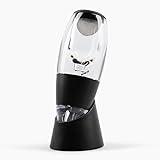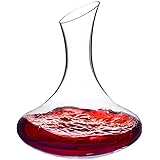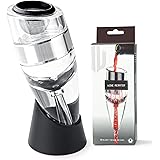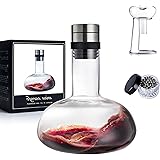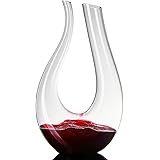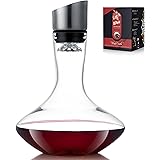Mastering Wine Glass Selection: An Expert’s Guide to the Best Stemware
Understanding the profound impact of proper stemware on your tasting experience is fundamental to appreciating fine wine. As Madelene Pouquette, a certified sommelier and co-founder of Wine Folly, demonstrates in the accompanying video, selecting the best wine glasses involves a discerning eye for quality, usability, and the subtle nuances that elevate aroma and palate perception.
This comprehensive guide delves deeper into the principles Madelene introduces, offering expert insights into what truly defines an exceptional wine glass. We explore the critical factors influencing performance, compare various high-end options, and provide a framework for making informed decisions in your own wine glass selection journey. Ultimately, the perfect glass empowers you to unlock the full potential of every pour.
1. Demystifying the Anatomy of a Superior Wine Glass
The quest for the best wine glasses begins with a detailed examination of their construction and materials. While aesthetics play a role, the functional design elements are paramount to enhancing the wine tasting experience. Madelene highlights several key attributes that distinguish quality stemware from the ordinary, influencing everything from perceived flavor to practical maintenance.
The Crystal Advantage: Beyond Standard Glass
At the heart of high-quality stemware lies crystal, a material superior to standard glass for several compelling reasons. Crystal boasts enhanced refractive index, giving it a brilliant sparkle and clarity that truly showcases the wine’s color. Crucially, its inherent strength allows for much thinner rims and bowls, which are critical for an unimpeded tasting experience.
Historically, crystal contained lead, which contributed to its brilliance and pliability. However, modern advancements have largely shifted towards lead-free crystal, often incorporating minerals like zinc or magnesium alongside silica. This innovation maintains the desirable qualities of traditional crystal—its resonance, clarity, and thinness—without the concerns associated with lead. The result is an elegant, durable, and highly functional vessel that amplifies the wine’s inherent characteristics.
Manufacturing Excellence: Hallmarks of Quality
Scrutinizing the manufacturing process reveals much about a glass’s pedigree and performance. Madelene identifies several points of inspection crucial for assessing quality stemware:
- **Multi-piece vs. Seamless Construction:** Lower-cost glasses often feature stems and bases fused to the bowl as separate units, creating visible seams. Premium, hand-blown glasses, conversely, are typically crafted from a single molten piece of crystal, resulting in a seamless, elegant structure that is both stronger and more aesthetically pleasing.
- **The Stem: Pressed vs. Pulled:** A pressed stem, often identifiable by a subtle seam, indicates a more mechanized manufacturing process. In contrast, “pulled” stems, characteristic of finer stemware, are drawn directly from the bowl, creating a smooth, uninterrupted transition that contributes to the glass’s overall balance and delicate feel.
- **Rim Thickness: The Gateway to Flavor:** Perhaps the most critical design element for sensory perception is the rim. A thin, finely polished rim, almost imperceptible to the lips, minimizes interference between the drinker and the wine. A thicker, rolled, or “beaded” rim can create a distraction, subtly altering the wine’s entry to the palate and potentially diminishing the perception of its delicate nuances. The goal is to make the wine feel as though it’s “floating into the air,” as Madelene eloquently describes, creating an unhindered delivery.
- **Bowl Quality: Flawless Presentation:** The internal smoothness and clarity of the bowl are vital for both visual appeal and the unimpeded swirling of wine. Imperfections, such as ribbing or inconsistencies from rapid manufacturing, can detract from the wine’s visual presentation and potentially affect how aromas are collected and perceived. A perfectly smooth, optically clear bowl ensures an unblemished view of the wine’s color and allows for optimal aromatic development.
2. Usability and Durability: Practical Considerations for Stemware
Beyond the sensory impact, the practicality of wine glasses is a significant factor in their long-term satisfaction. Madelene emphasizes that a great glass must also be user-friendly in daily life. This includes ease of cleaning, convenient storage, and reasonable durability, especially for those investing in higher-end options.
Balancing Delicacy with Resilience
There’s an inherent tension between the desire for extremely thin, delicate stemware and the need for everyday resilience. High-end glasses, particularly hand-blown varieties, are celebrated for their ethereal lightness and slender stems, often described as having the fragility of “hummingbird bones” by some wine writers. While this delicacy contributes to their elegance and tactile experience, it necessitates careful handling.
For glasses with extremely thin stems, holding them by the base is often recommended to prevent breakage, especially for those with larger hands. However, some premium brands, like Zalto, ingeniously design their thin-walled crystal to be surprisingly pliable and resilient, demonstrating that extreme thinness does not always equate to fragility. This balance of delicacy and resilience represents a triumph of engineering in the world of fine stemware.
Ergonomics and Maintenance
Practical considerations extend to the glass’s design for cleaning and storage. A bowl with a sufficiently wide opening, such as the Riedel Extreme Cabernet glass mentioned, allows for easy hand-polishing—a crucial detail for maintaining crystal clarity. Additionally, while some high-end glasses are monumental in size, their form should ideally allow for storage in standard cabinet spaces without significant inconvenience.
Ultimately, the best red wine glasses offer a harmonious blend of sublime design and practical functionality. They should enhance the wine experience without becoming a burden to maintain or store, ensuring they are used and enjoyed regularly.
3. A Comparative Exploration of High-End Universal Glasses
Madelene’s video provides a fascinating side-by-side sensory evaluation of several leading universal wine glasses. Universal glasses are designed to perform admirably across a broad spectrum of wine styles, making them a popular choice for enthusiasts seeking versatility without sacrificing quality. We delve into the specifics of these premium offerings, considering their design philosophies and performance characteristics.
The Contenders: Hand-Blown vs. Machine-Made Precision
The comparative tasting featured a selection of acclaimed universal stemware, highlighting both artisanal hand-blown craftsmanship and advanced machine-made precision:
- **Jancis Robinson & Richard Brendon ‘The One’**: Introduced in 2018, this Austrian-made, hand-blown crystal glass retails for approximately $56 per stem. Its defining characteristic is a notably smaller diameter opening, which Madelene speculated might be optimized for aromatic “weird stuff” like Riesling or sparkling wines, despite being a universal design.
- **Zalto Denk’Art Universal**: A universally acclaimed classic, this hand-blown Austrian glass commands a price point of around $59 per stem. Known for its austere lines and distinctive pliability, the Zalto’s larger diameter opening proved superior for expressing the fruit-forward nature of the Pinot Noir tasted. Its reputation for durability, despite its delicate appearance, is a significant selling point.
- **Zwiesel 1872 Select Riesling Grand Cru**: This German-made offering, priced around $43 (38 Euros), represents a long-standing tradition of glass manufacturing. While specifically named a “Riesling Grand Cru” glass, it was included in the universal comparison, suggesting its broad applicability in the Zwiesel 1872 Select series.
- **Gabriel-Glas Gold Edition (Hand-blown)**: Designed by a Swiss individual and made in Austria, the hand-blown Gold Edition retails for approximately $62 per stem. Its distinctive curvy shape and larger diameter opening contributed to a sequential revelation of aromas, making flavor identification quite engaging.
- **Gabriel-Glas Standard (Machine-made)**: Identical in shape to its hand-blown counterpart, this machine-made version is a remarkable value at just under $30 per stem (Madelene notes $29.99 on Wine Folly’s site). While displaying slight manufacturing ribbing, its performance in the tasting was notably on par with much more expensive options, making it a compelling choice for discerning drinkers on a budget.
Sensory Evaluation: A Pinot Noir Case Study
The choice of a 2014 Lost and Found Pinot Noir for the tasting was strategic; its aromatic complexity—red fruit, floral notes, subtle earthiness—made it an excellent candidate for revealing the strengths and weaknesses of each glass design. Madelene conducted both a smell and taste test, meticulously observing how each glass manipulated the wine’s sensory profile.
Aromatics: The Nose Knows
The smell test highlighted the critical role of the bowl’s opening diameter. Glasses with a smaller opening, like the Jancis Robinson ‘The One’, initially presented a more concentrated, sometimes even “aseptic” or alcoholic, nose. This required the taster to move their nose away from the rim to perceive individual aromas, suggesting that the smaller aperture might over-concentrate volatile compounds, potentially overwhelming the olfactory receptors.
Conversely, glasses with larger diameter openings, such as the Zalto and Gabriel-Glas designs, allowed for a more expansive and immediate expression of the wine’s fruit character. They diffused the aromatics more effectively, allowing complex layers of raspberry, strawberry, and hibiscus to emerge distinctly. This demonstrates how bowl geometry directly influences the collection and delivery of aromatic compounds to the nose, shaping the initial sensory impression.
Palate: The Taste Experience
The taste test further underscored the influence of glass design, particularly the rim’s interaction with the lips and the wine’s distribution on the palate. The Jancis Robinson glass, with its smaller opening, delivered the wine in a highly focused stream, creating an initial “single point explosion” on the palate. This intense delivery seemed to emphasize acidity and tart fruit, with tannins appearing slightly reduced.
In contrast, glasses with broader openings, like the Zalto and Gabriel-Glas, distributed the wine more broadly across the palate, akin to a “fan.” This allowed a wider range of taste receptors to engage simultaneously, promoting a more harmonious perception of fruit, tannin, and acidity. The Gabriel-Glas, in particular, managed to convey a perception of lighter body and fresh fruit, a testament to how the glass can subtly alter the perceived texture and flavor profile of the same wine. Madelene observed minimal difference in taste perception between the hand-blown and machine-made Gabriel-Glas, despite the slight variation in rim thickness, emphasizing the dominance of overall shape.
4. Finding Your Perfect Universal Wine Glass
Madelene’s exploration reinforces a crucial truth: there is no single “best” wine glass for everyone. Personal preferences, physiological differences (like nose size), and even the specific wine being served all play a role. However, the tasting revealed clear frontrunners for a universal application, particularly with red wines like Pinot Noir.
Top Performers and Value Propositions
For Madelene, the Zalto Denk’Art Universal and both Gabriel-Glas variants (hand-blown and machine-made) emerged as favorites for their exceptional performance with the Pinot Noir. The Zalto, though a premium investment, truly lived up to its lauded reputation, delivering a robust and delicious expression of the red wine’s character. Its combination of elegance, performance, and surprising resilience makes it a benchmark in high-end stemware.
The machine-made Gabriel-Glas presented a particularly compelling value proposition. Performing nearly identically to its more expensive hand-blown counterpart and other high-end options, it offers an astonishing level of quality for its price point. While the visible manufacturing ribbing might deter those seeking absolute crystal clarity, its sensory performance—the ultimate measure—was exceptional. This demonstrates that innovative machine-made processes can now rival artisanal craftsmanship in delivering an optimized tasting experience, making premium wine experiences more accessible.
Beyond Universality: Specialized Stemware
While universal glasses are versatile, Madelene’s comments on the Jancis Robinson ‘The One’ glass hint at the continued relevance of specialized stemware. Its smaller opening, which was less ideal for the Pinot Noir, might prove extraordinary for wines where aromatic intensity and focus are desired, such as sparkling wines, high-acid Rieslings, or unique dessert wines. This underscores the idea that certain wine styles can benefit immensely from glasses tailored to their specific aromatic and structural profiles.
Ultimately, the journey to finding your ideal collection of wine glasses is a personal one. It involves understanding the interplay of material, design, and sensory perception, guided by expert insights. Investing in quality stemware, whether a versatile universal glass or a specialized vessel, is an investment in enhancing every moment you spend with wine. It allows the subtle intricacies of each vintage to truly shine, transforming a simple pour into a profound sensory experience. Considering these factors will help you choose the best wine glasses for your collection.


